Pennsylvania is one of the states with a large number of native and invasive fish. From small minnow fish to largemouth bass, the state is represented by species of different sizes.
Fish of the state are further known to be connected with species in The Great Lakes.
From native species to Asian and European origin fish, Pennsylvania is home to some of the most common species in the US as follows.
Table of Contents
1. Bluegill
One of the most common species in Pennsylvania and the region of The Great Lakes are Bluegill (Lepomis macrochirus).
This is a species of dark olive coloring with darker green bands with a darker color head that often has purple nuances.

A size of up to 12 inches and a flattened shape is specific to the species.
Bluegill fish are further known for their insects and small fish.
They are also common prey for larger fish in the Northern parts of the state.
2. Largemouth Bass

A common predator of Bluegill, Largemouth Bass (Micropterus salmoides) is one of the largest predator fish of the state.
It also represents one of the most prized game fish in Pennsylvania as it puts up a fair fight on the hook.
Largemouth Bass are important to the local ecosystem as they prey on invasive species in The Great Lakes such as the Round Goby.
However, Largemouth Bass is also invasive and destructive outside its native range in other parts of the world.
This fish also multiplies in high numbers. Spawning is seen in the same place as it doesn’t travel to its native range such as other species.
3. Brown Trout

This species of trout (Salmo trutta) is identified by its multiple brown dorsal spots and white or yellow belly.
A common prize for fishermen, this species is abundant in mid to high elevations across the state.
It feeds on aquatic and terrestrial invertebrates and flies. The fish may also consume some of the smallest fish of other species.
This species can live very long lives as some of the longest-living Brown Trouts can survive up to a couple of decades.
Still, low male survival rates are noted for the species after spawning.
Brown Trout that migrate also show the highest chances of surviving up to 20 years as they have wider food choices in multiple locations.
4. Green Sunfish
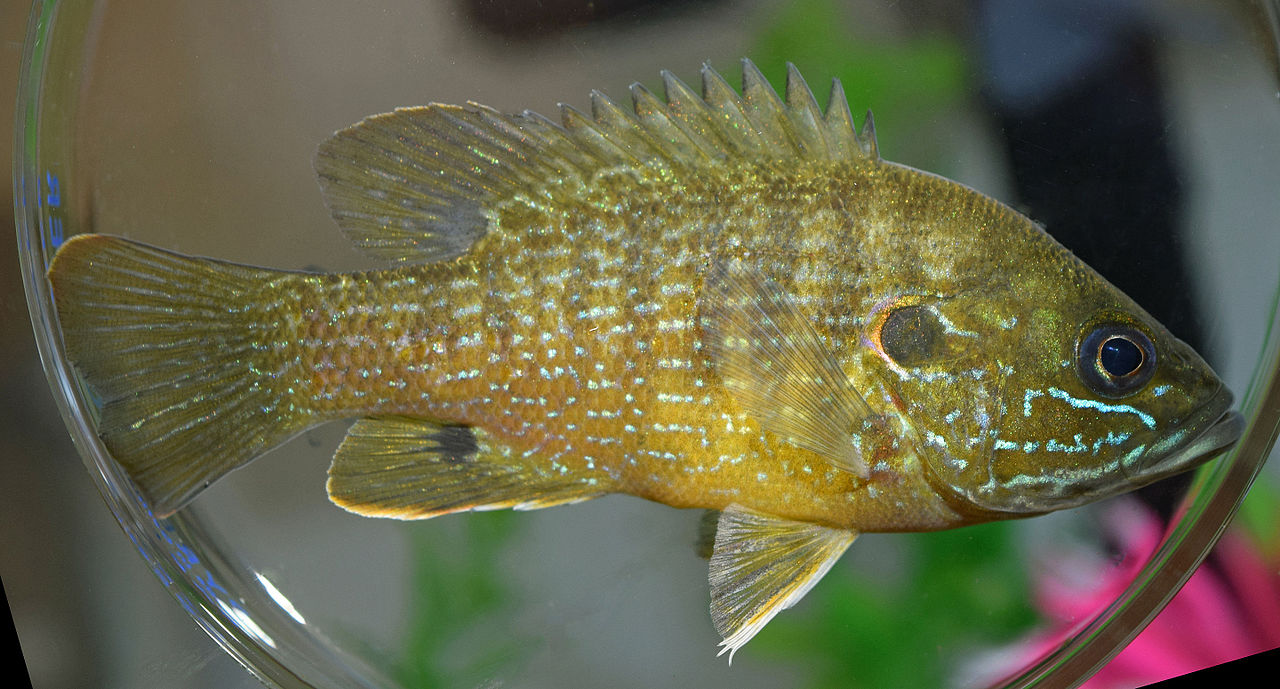
This dark-flattened fish (Lepomis cyanellus) is found in lakes and ponds across the state. It prefers areas with gravel which it relies on for food.
Much of the lives of the species is spent at the bottom of lakes, next to gravel, in hiding.
Green Sunfish survive on diverse aquatic foods. They eat crayfish, small fish, algae, and invertebrates.
Green Sunfish spawning is specific to the summer months but it may vary in location.
5. Pumpkinseed

This flattened shape species (Lepomis gibbosus) is known for its colorful body. It has green, yellow, orange, and red coloring and a banded body.
Pumpkin fish are named after their shape which resembles the seeds of pumpkins.
A common native species in the state, Pumpkinseed fish are some of the most invasive species in Europe.
Fish of this family mostly eat insects and they may also consider other prey such as mollusks.
6. Smallmouth Bass
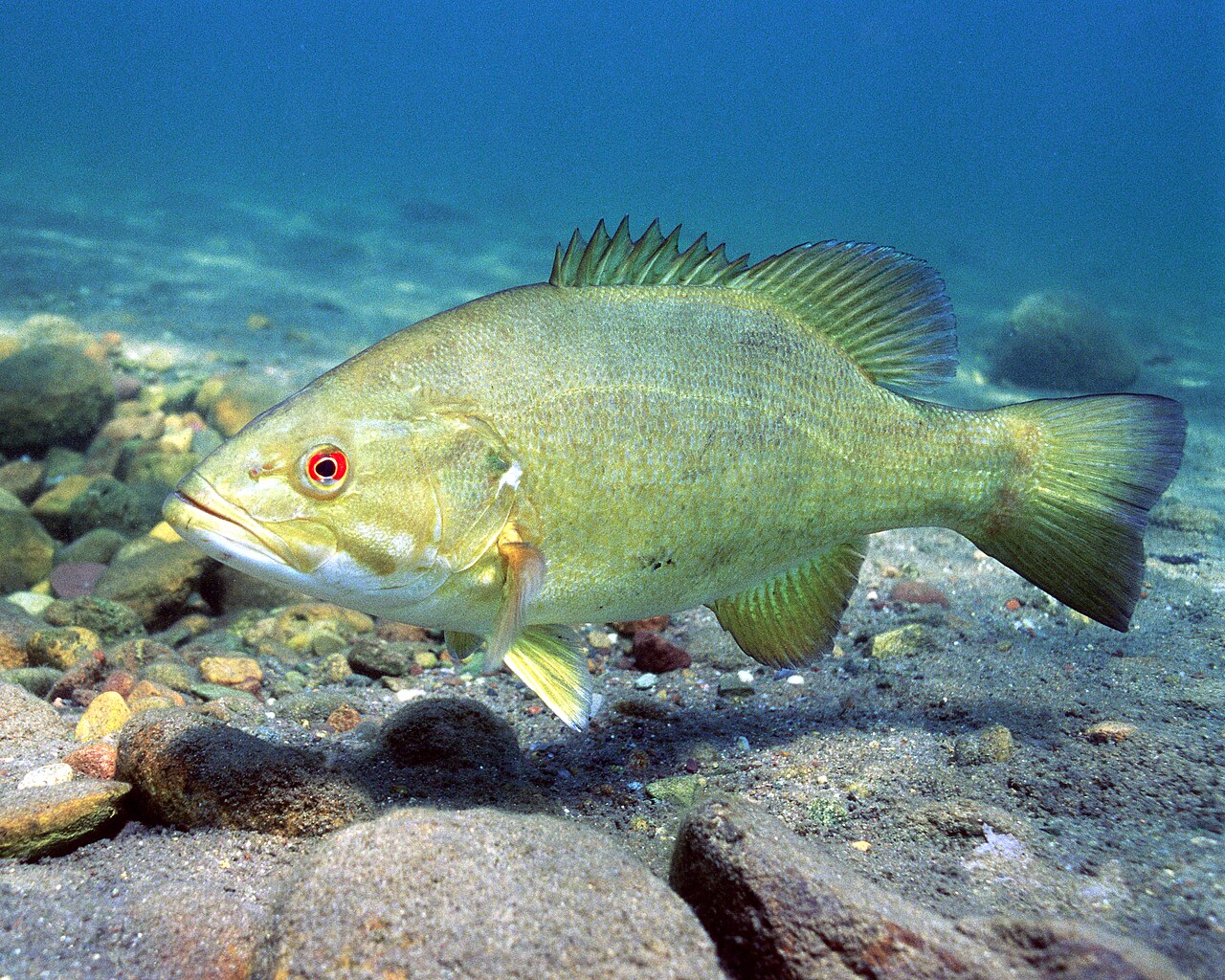
Another common species of gamefish in Pennsylvania is the muscular Smallmouth Bass (Micropterus dolomieu).
This is a species with black stripes along its body which also make it known as the Brown Bass.
Both Largemouth and Smallmouth Bass are native to the state. However, Smallmouth Bass lives in clear water as opposed to its larger cousin.
It prefers rivers and streams. Smallmouth Bass prefer to migrate in search of ideal spawning locations, preferably in deeper areas of streams and rivers.
7. European Carp

One of the largest distribution invasive species partly domesticated in the state is The European Carp (Cyprinus carpio).
This is one of the largest fish local fishermen can catch in the state.
Some of the largest fish of the species may reach weights of up to 30 lbs.
This species is highly adaptable as it can live almost anywhere around the state. It prefers slow waters, however.
Areas where the larger European Carp are spotted the most include areas with dense aquatic vegetation.
8. Brook Trout

Brook Trout (Salvelinus fontinalis) is one of the prized species in Northwestern areas of the state.
Unlike other native species of trout, Brook Trout has a dark green appearance with lighter green spots on the side.
This is a species that grows up to a size of 20 inches with most individuals measuring a bit less, anywhere between 10 and 15 inches.
Male Brook Trout change ventral coloring when spawning. Their bellies turn red from bright typical color.
9. Creek Chub

This thin fish (Semotilus atromaculatus) is identified by a black lateral stripe that’s interrupted in the middle.
Dark spots on its dorsal side are known to inspire its name.
Fish of the species live on the edges of lakes and ponds, at least in their young life stages.
Normally a carnivore, Creek Chub fish can also eat all types of food in periods when they can’t find suitable prey.
Small fish and aquatic insects are among their common prey. Vegetation and the larvae of various terrestrial insects may also be eaten by this fish.
Creek Chub are migratory fish in the spawning period. They seek out safer areas for reproduction.
10. Rainbow Trout

Rainbow Trout (Oncorhynchus mykiss) is one of the most common game fish and aquaculture fish in the state. Its presence is often relied upon as a biological control agent to indicate water purity levels in a given habitat.
The species is seen in different forms and it has been introduced in the area of the Great Lakes.
If males struggle with a low spawning survival rate elsewhere, males here show a high survival rate.
Rainbow Trout might travel to their native area for spawning.
This is also a fish that can undergo a process of adjustment from freshwater to saltwater. It changes its physical traits during this process.
11. Redbreast Sunfish

This fish (Lepomis auritus) has a gray or olive-to-gray dorsal color. A red underbelly is also specific to the species, as its name implies.
Females have a considerably larger red section on the underbelly.
A common fish in multiple rivers that flow into The Atlantic, Redbreast Sunfish is one of the preferred species of anglers.
This species feeds on insects and the small fish of other species. Aquatic insects, crayfish, and dragonflies are all part of its diet.
12. Eastern Blacknose Dace

These small fish (Rhinichthys atratulus) play an important role in the aquatic ecosystem of the state. It’s seen as easy prey for some of its largest predators.
The Eastern Blacknose Dace is a species with a long black lateral line.
It can be found in various habitats with a preference for rocky terrains.
The small size of the species means it may only feed on invertebrates in the small rocky rivers in the Northern parts of the state.
13. Rock Bass

This type of bass (Ambloplites rupestris) likes the cool waters of the Northern habitats in the state.
It prefers rocky lakes where it swims at the bottom. Some type of vegetation is preferred in its habitat.
Many Rock Bass fish are found near the shore of the lakes as they aren’t too afraid of animal and human activity.
This species shares its habitat with other common fish such as the smallmouth bass.
Both species can be prey in the food chain ecosystem for larger bass species.
14. Yellow Perch

These small fish (Perca flavescens) may reach a maximum length of 10 inches. They come in different green nuances with a common olive morph.
Fish of this species are native to The Great Lakes and also live in other common areas such as reservoirs.
A common species for anglers, Yellow Perch is a fish that can be eaten being considered one of the tasty species in the state.
The species is commercially fished from these large lakes on both the Canadian and the US sides.
15. White Sucker

This slender long fish (Catostomus commersonii) comes in different other names such as The Bay Fish.
Its name is inspired by its elongated mouth which looks like long lips which help it suck food at the bottom of streams and lakes.
A gray color or a gray-to-yellow color is specific to this species.
This species grows to an average length of 15 inches with some large individuals reaching a length of up to 20 inches.
It shows tolerance for different habitats and it lives in lakes and streams. In Pennsylvania, the species is found in the region of The Great Lakes.
16. Black Crappie

This flattened species (Pomoxis nigromaculatus) is one of the darkest types of fish in the state.
It has a mostly black color with bright lateral patterns and a small size of up to 8 inches.
These types of fish are seen in the spawning season when they retreat to shallow waters.
Depths of only up to a few feet are preferred for spawning in late spring or early summer.
It’s males that arrive first as they dig into soft sandy soils to create nesting sites. These sites are often selected based on some type of natural barrier such as tall vegetation to keep predators away.
17. Banded Killifish

While there are over 1.000 species of Killifish in the world, only this species (Fundulus diaphanus) is found in Pennsylvania.
Insects and mollusks are some of the typical types of prey for this species.
Small by nature, these fish are also seen as prey for some of the largest predators in the state, such as largemouth bass.
Living in freshwater lakes and streams, this small fish is only seen in groups. Adults live in small groups compared to juveniles.
Both adults and juveniles travel in groups to avoid predation.
18. Channel Catfish

Fish, clams, and different snails are some of the most common foods of the popular Channel Catfish (Ictalurus punctatus).
This is one of the best-known species in the state.
High adaptability to muddy waters and to look for food in the dark are attributed to the species.
It has taste buds all over its body, especially on the whiskers around its mouth.
This means it picks up the scent and taste quicker than most other fish and this allows it to quickly find food and grow up to 21 inches.
19. Mottled Sculpin

This type of fish (Cottus bairdii) lives in highly oxygenated waters. These are small rivers and upland streams.
It may also live in lakes, in the areas water isn’t as stagnant.
Mottled Sculpin shares its habitat with multiple larger predator fish such as trout, which also eat its young.
This fish species is known for eating insects and larvae or the small fish it can find in its rapid and oxygenated waters.
20. Fallfish

Fallfish (Semotilus corporalis) is one of the beginner-friendly species for amateur fishermen and one of the most common species for anglers.
This is a small fish that rarely grows more than 5 inches. Only record-holding fish of the species have been measured to have a size of around 15 inches.
In their young days, these fish can only eat chironomid flies. As they grow, they can also eat the small fish of other species.
Their diet makes these fish one of the typical species caught in fly fishing.
21. Brown Bullhead

Brown Bullheads (Ameiurus nebulosus) are among the local species of The Great Lakes.
These are fish that can live and even thrive in less-than-ideal muddy conditions. A low oxygen level in their habitat also means these fish have few natural predators.
Brown Bullheads are known for having a green to brown dorsal color, yellow side coloring, and gray to white ventral coloring.
This is a species that feeds at the bottom of lakes and slow-moving rivers.
Fish of this genus feed on almost anything they can find at the bottom of lakes such as small fish, crustaceans, and algae.
22. Golden Shiner

This small fish (Notemigonus crysoleucas) is found around The Great Lakes. It rarely grows to a size of 5 inches.
Preferring lakes and ponds, fish of this group may also choose to live in areas of rivers where currents are slow.
Its reduced size and habit limit its diet, even if it can be categorized as an omnivore. Most Golden Shiner fish feed on plankton.
This small species also show an immediate response to water pollution.
Even slightly elevated mercury levels can delay its growth and eventually kill this species in its natural habitat.
23. White Perch

These small fish (Morone americana) inhabit The Great Lakes and fishers across the state.
A general negative role in the ecosystem has been tied to these fish. White Perch is a species that feeds on the eggs of other fish.
Its feeding habits are highly destructive as it tends to eat many walleye and other fish species eggs which are prey for larger fish.
The introduction of these fish in fishers also limits small prey fish numbers.
A vigorous reproductive status in which a female can lay more than 100.000 eggs at a time is also noted for this species.
24. Freshwater Drum

Freshwater Drum (Aplodinotus grunniens) is the only species in the state and the country to live exclusively in freshwater.
This species is also known as The Grunt Fish. Its nickname comes from the grunting noise the fish is known for.
A grunt-like noise is made by males which only make this sound when spawning.
Fish of this family are present in very high numbers across the Northeast.
Clearwater is preferred by Freshwater Drum as it needs to make its way towards small prey such as flies and fish.
Small flies are part of its diet in the spring and early summer while small fish are preferred by Freshwater Drum in late fall as temperatures drop.
25. Chain Pickerel

Chain Pickerels (Esox niger) are some of the most common fish for anglers around the world. They also live in Pennsylvania.
This fish is known for its very strong teeth, its long slender body, as well as its varied diet based on its predatory skills.
It’s one of the few species in the state that can eat small water snakes. It shows opportunistic feeding grabbing the chance to catch any type of prey including toads, insects, and worms.
Bass is successfully used as bait by anglers as these fish can swallow an entire bass fish.
26. Common Shiner

Small size is characteristic of the Common Shiner (Luxilus cornutus) which rarely grows pasts a size of 5 inches.
This silver-gray species has dark olive dorsal coloring.
It lives in some of the shallowest ponds and streams in the state where it prefers rocky bottom areas.
An omnivore diet is specific to the Common Shiner. This is a species that feeds on insects, small fish, eggs, larvae, and insects.
Some of the largest predatory fish such as Chain Pickerel feed on the Common Shiner.
27. Goldfish

Goldfish (Carassius auratus) are an introduced species to add decor to ponds.
Most fish of this genus in the state live on private property. The high popularity of the fish makes them a top choice for aquariums as well.
These fish are thoroughly studied and are believed to have the capacity to remember human faces.
Goldfish are also known for having the capacity to distinguish between basic colors.
Almost no predators are found in the state for goldfish as the species grows in an enclosed environment.
The species also shows low aggression levels towards other decorative species.
28. Yellow Bullhead

A large fish, Yellow Bullhead (Ameiurus natalis) is among the few considerable-size species which represent a minor interest to local fishermen.
This fish species is known for its varied diet which includes both living and dead fish.
Yellow Bullhead fish live in areas with sand and muck. Rivers, lakes, and ponds are its preferred habitats.
It’s here that fish come out to feed at night, as one of the most active nocturnal omnivores in the state.
Yellow Bullhead fish also eat algae and other aquatic plants. The decaying plant matter is also consumed, alongside its more common fish and worm prey.
29. Tessellated Darter
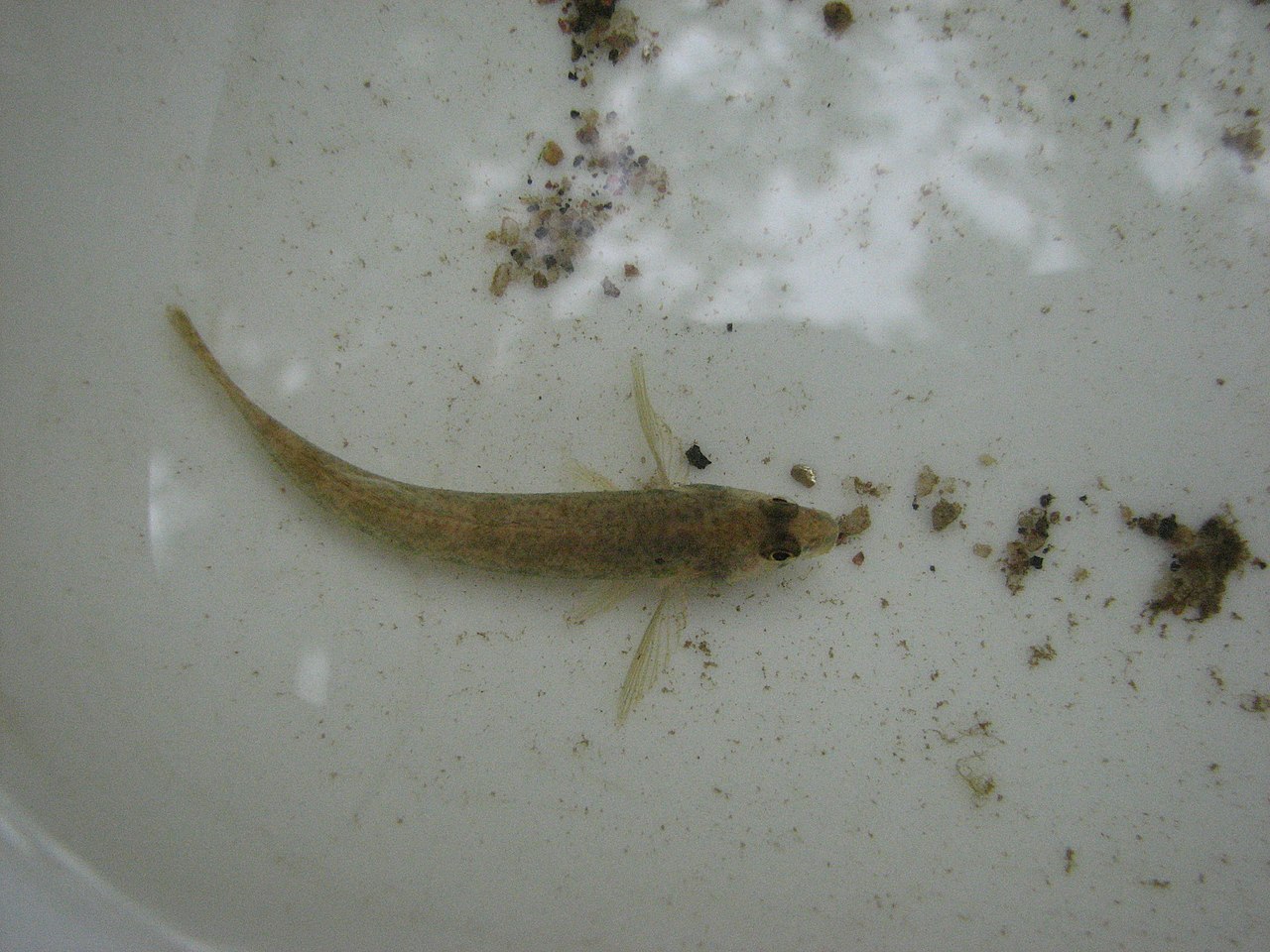
Coastal areas are normally preferred by the Tessellated Darter (Etheostoma olmstedi).
This is a small fish species that grows between 1 and 3 inches. They live in small rivers and streams, especially in the areas of these waters with plenty of rocks at the bottom.
A gray-to-white color is specific to this small fish. Darker areas are always located on its dorsum as its ventral color is nearly white.
30. River Chub

River Chub (Nocomis micropogon) are common in the area of The Great Lakes.
This is an olive-color species with silver to white ventral coloring and a black lateral stripe.
A pink or yellow ventral color is noted for the mature males ready to spawn.
Fish of this category average size of around 5 inches with some of the largest recorded River Chub measuring just over 13 inches.
Moderate currents in rivers are among their common areas across Northeastern territories in the country.
This is a species that may be used to indicate water quality levels in the state as it shows low tolerance to pollution and
31. American Eel

Pennsylvania and the region of the Great Lakes mark the Western limit of this Atlantic Ocean species.
American Eel (Anguilla rostrata) is a species that looks like a snake. It has an almost black color and scales so small it almost looks to have perfectly-smooth skin.
A burrowing nature and a habit to create shelters in the ground make this species a common sight in lakes with sandy soils.
However, American Eel can also live in rivers, streams, and even the ocean.
This species has a special concern status due to diminishing numbers in the wild and limited numbers across American fisheries.
32. White Crappie

White Crappie fish (Pomoxis annularis) have multiple dark bands that make them easy to identify.
These fish may grow to a maximum size of just over 5 lbs and are found in The Great Lakes.
They can also be found in man-made reservoirs as they show some levels of tolerance for water that aren’t clear.
White Crappie fish prefer large lakes and large reservoirs.
33. Fantail Darter

Streams with cobbles are among the ideal habitats for the fast-swimming Fantail Darter (Etheostoma flabellare).
Brown and black or yellow-brown base coloring with black spots is specific to this species.
Its reduced size also makes the Fantail Darter a species that feeds on small insects such as mayflies.
The biggest enemies of the species include low oxygen and pollution.
34. Eastern Mosquitofish
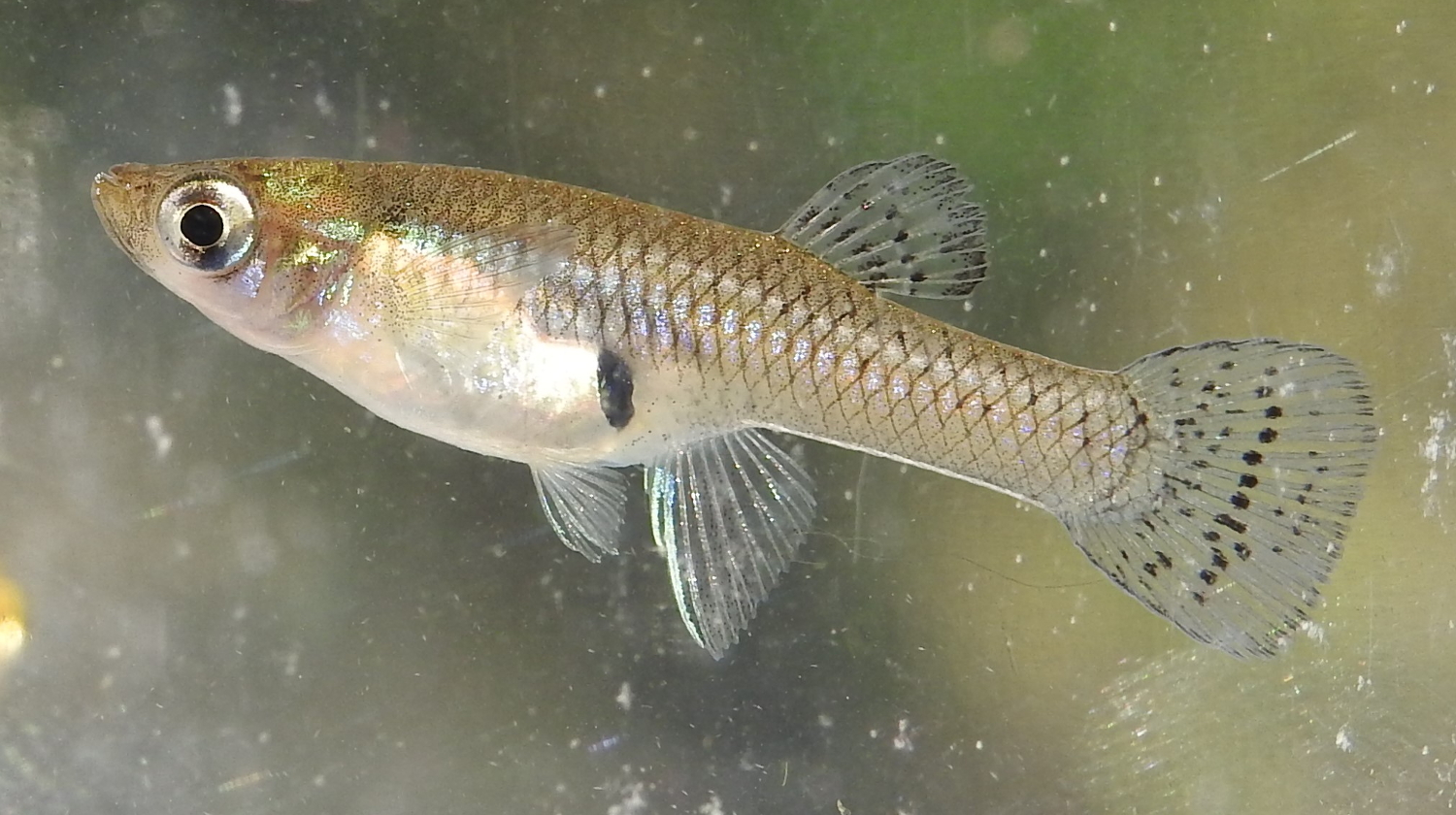
This small fish species (Gambusia holbrooki) feeds on phytoplankton and algae.
It lives in lakes and ponds with algae, areas where these many aquatic invertebrates are common.
Eastern Mosquitofish are also one of the smallest species in the state. It measures around 1.5 inches and it shows a characteristic of having males smaller than females.
Female Eastern Mosquitofish are also brighter while males have an olive-brown color.
35. Northern Hog Sucker

A common sight in various glasses of water with pebbles, this is a species (Hypentelium nigricans) that feeds by sucking.
As its name implies, the Northern Hog Sucker is a species that sucks food from the bottom of lakes and rivers.
Algae represent a common food for the species which sucks it from rocks and pebbles.
Small insects and mollusks are also part of its diet. This species spawns in May and June.
36. Walleye

Some of the deepest areas of The Great Lakes and rivers in the Northern part of the state are ideal habitats for Walleye (Sander vitreus).
This common fish species only move to shallow water for spawning.
They show turbid water tolerance and are often caught on the windiest days when waters are far from clear.
This species grows to a maximum weight of just over 20 lbs and it has no real predator given its size.
37. American Gizzard Shad

Freshwater lakes are the home of the American Gizzard Shad (Dorosoma cepedianum). This is a fish that also lives in brackish water outside of the state.
American Gizzard Shad fish feed in the lowest depths of lakes where they eat plankton.
A distinct trait of the species is the capacity to cross-spawn into a hybrid with Threadfin Shad.
Quick growth rates are also specific to its hybrid morph.
38. Northern Snakehead

Northern Snakeheads (Channa argus) are invasive in Pennsylvania. This is one of the rapid-growth species in the country with a significant spread over the past 10 years.
Multiple management methods have been put in place against it without real success.
Muddy bottom lakes are ideal as their habitat. It’s here that Northern Snakeheads feed on invertebrates and amphibians.
This species takes on the color of its habitat with a tale of gray-white coloring.
39. Amur Carp

Amur Carp fish (Cyprinus rubrofuscus) have been introduced to North America and Pennsylvania.
This is a species believed to be related to the European Carp. While a different species, it shows some similar traits to the European Carp.
For example, both fish have a similar taste. Amur Carp hasn’t made it as one of the state’s preferred fish for eating due to its intra-muscular bones.
40. Rainbow Darter
Shallow rocky habitats mark the ideal location for the Rainbow Darter (Etheostoma caeruleum).
A tan color with dark brown spots, and blue, and orange stripes make up the colorful appearance of this species.
Living around The Great Lakes, this species remains small. It grows to 2-3 inches and it can be spotted when walking next to the shallow lake and river water.
Rainbow Darter fish are identified by their 3 black spots on the dorsum.
41. Greenside Darter

Greenside Darter (Etheostoma blennioides) can share its riffle habitat with Rainbow Darter. Multiple green spots along its fins and body differentiate this species.
The green patches across the body are only characteristic of males. Female Greenside Darters have transparent fins and not green fins like males.
While comparable by size, the Greenside Darter is still larger than the Rainbow Darter as it may reach a length of up to 5 inches.
Early spawning from March is specific to this species.
42. Johnny Darter

A stable species by numbers, Johnny Darter (Etheostoma nigrum) is some of the smallest freshwater fish in the country and the state.
They grow to an average size of 1.5 inches with only the largest individuals growing to a size of over 2 inches.
A yellow to brown base color is specific to Johnny Darter fish which also show brown spots along the body.
These small fish eat insects such as mayflies. They are common food for almost all large predators in their habitat including walleye.
43. Bluntnose Minnow

The small size is specific to the Bluntnose Minnow (Pimephales notatus). This is one of the most common freshwater fish in North America with a confirmed presence in Pennsylvania.
Fish of this family grows to a size of just over 2 inches with a record-holding length of 4.4 inches. It shows distinct lateral black stripes.
Algae, insects, and larvae are part of its diet.
This fish spawns from spring to mid-summer. Males are known to take on a red-orange ventral color when they spawn.
44. Mummichog
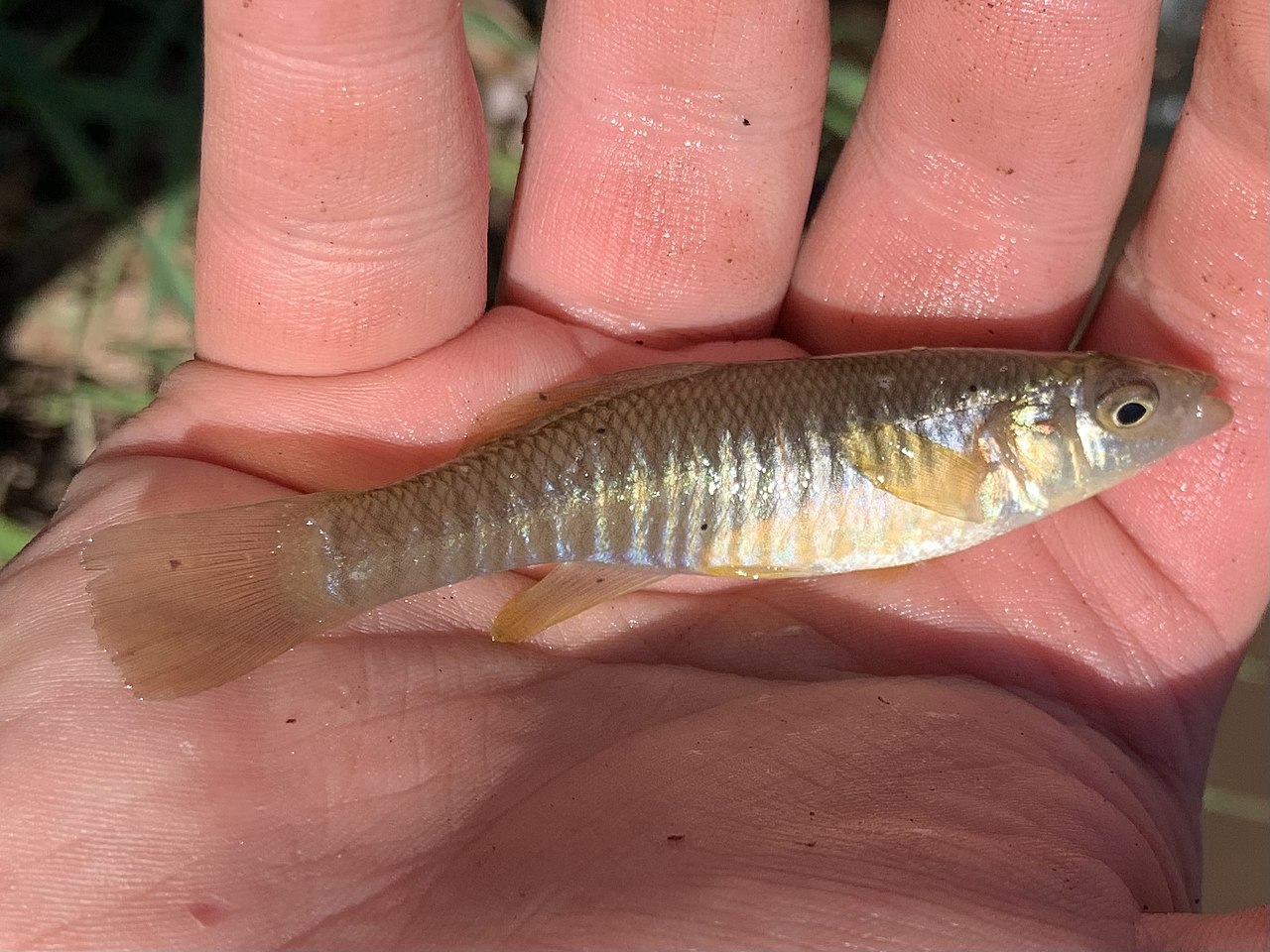
Mummichog fish (Fundulus heteroclitus) are found across the state. These fish are known to live in large numbers together.
The small fish is known to move upstream to areas with fewer predators to escape the cold winter months in the North.
It’s here that these fish burrow in the mud to create overwintering nests.
This small fish is often available as live bait for large predators. Still, Mumichog carries parasites and nematodes.
You can identify a Mummichog affected by parasites by its tendency to swim next to the surface of the water.
45. Central Mudminnow
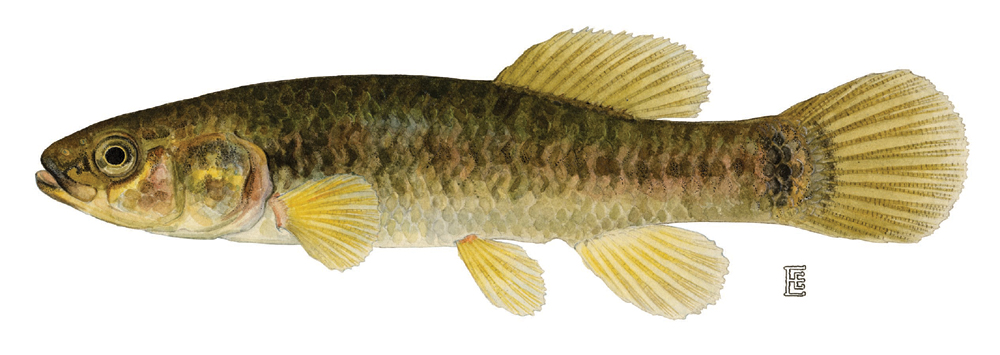
Central Mudminnow fish (Umbra limi) are slightly larger than small fish in the state such as Bluntnose Minnows.
Fish of this species have brown color on the dorsum and brown coloring with mottling on the sides.
This species grows up to a size of 4 inches and shows adaptability to living in lakes and streams.
These fish are easy to spot from April onwards as they begin to spawn. Even later in the summer, Central Mudminnows swim together in small groups.